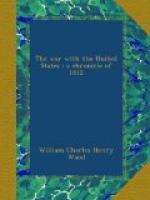Brown, the American general who had beaten Prevost at Sackett’s Harbour and who had now superseded Wilkinson, had made his advanced field base at Buffalo. His total force was not much more than Drummond’s. But it was all concentrated into a single striking body which possessed the full initiative of manoeuvre and attack. On July 3 Brown crossed the Niagara to the Canadian side. The same day he took Fort Erie from its little garrison; and at once began to make it a really formidable work, as the British found out to their cost later on. Next day he advanced down the river road to Street’s Creek. On hearing this, General Riall, Drummond’s second-in-command, gathered two thousand men and advanced against Brown, who had recommenced his own advance with four thousand. They met on the 5th, between Street’s Creek and the Chippawa river. Riall at once sent six hundred men, including all his Indians and militia, against more than twice their number of American militia, who were in a strong position on the inland flank. The Canadians went forward in excellent style and the Americans broke and fled in wild confusion. Seizing such an apparently good chance, Riall then attacked the American regulars with his own, though the odds he had to face here were more than three against two. The opposing lines met face to face unflinchingly. The Americans, who had now been trained and disciplined by proper leaders, refused to yield an inch. Their two regular brigadiers, Winfield Scott and Ripley, kept them well in hand, manoeuvred their surplus battalions to the best advantage, overlapped the weaker British flank, and won the day. The British loss was five hundred, or one in four: the American four hundred, or only one in ten.
Brown then turned Riall’s flank, by crossing the Chippawa higher up, and prepared for the crowning triumph of crushing Drummond. He proposed a joint attack with Chauncey on Forts Niagara and George. But Chauncey happened to be ill at the time; he had not yet defeated Yeo; and he strongly resented being made apparently subordinate to Brown. So the proposed combination failed at the critical moment. But, for the eighteen days between the battle of Chippawa on the 5th of July and Brown’s receipt of Chauncey’s refusal on the 23rd, the Americans carried all before them, right up to the British line that ran along the western end of Lake Ontario, from Fort Niagara to Burlington. During this period no great operations took place. But two minor incidents served to exasperate feelings on both sides. Eight Canadian traitors were tried and hanged at Ancaster near Burlington; and Loyalists openly expressed their regret that Willcocks and others had escaped the same fate. Willcocks had been the ring-leader of the parliamentary opposition to Brock in 1812; and had afterwards been exceedingly active on the American side, harrying every Loyalist he and his raiders could lay their hands on. He ended by cheating the gallows, after all, as he fell in a skirmish towards the end of the present campaign on the Niagara frontier. The other exasperating incident was the burning of St David’s on July 19 by a Colonel Stone; partly because it was a ’Tory village’ and partly because the American militia mistakenly thought that one of their officers, Brigadier-General Swift, had been killed by a prisoner to whom he had given quarter.




